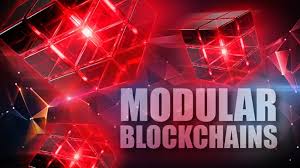A modular blockchain is a modern type of blockchain architecture. Unlike traditional blockchains that do everything in one place, a modular blockchain breaks the system into different specialized layers. This separation helps improve speed, efficiency, and scalability.
What Are Monolithic Blockchains?
Traditionally, popular blockchains like Bitcoin and Ethereum handle everything in one place. These blockchains are called Monolithic blockchains, and they must perform four main functions all at once:
- Transaction Execution – processing transactions.
- Consensus – agreeing on the order of transactions.
- Data Availability – storing and making transaction data accessible.
- Settlement – ensuring transactions are final and secure.
As monolithic blockchains grow, the amount of data increases, making the system slower and more expensive to use. As a result, innovation becomes difficult. Modular blockchains aim to fix these issues.
What Is a Modular Blockchain?
Modular blockchains divide these four functions into separate layers. That way, each layer does one specific task, making everything efficient and flexible. The common layers in modular blockchains include:
- Execution Layer – executes transactions and checks if they are valid.
- Settlement Layer – verifies proofs, handles disputes, and connects different execution layers.
- Consensus Layer – ensures everyone agrees on the order of transactions.
- Data Availability Layer – makes sure transaction data is stored and available to all participants.
Most modular blockchains mainly focus on one or two layers, not all four.
Example: Celestia (The First Modular Blockchain)
Celestia is widely known as the first real modular blockchain. It focuses only on:
- Data Availability
- Consensus
It doesn’t handle execution or settlement by itself, but allows other blockchains or rollups to build on top of it and handle those.
Origins of Modular Blockchains
The term “modular blockchain” was first mentioned in 2018 in a paper by Mustafa Al-Bassam and Vitalik Buterin (a co-founder of Ethereum). In 2019, Al-Bassam released a whitepaper for LazyLedger (which later became Celestia), explaining a blockchain designed only for sorting and storing data.
However, before Celestia, other projects like Polkadot and Cosmos were already working with settlement layer modular blockchains. Rollup solutions like Arbitrum and Optimism, which launched before Celestia, focused on execution layers.
Now in 2024, the blockchain ecosystem has multiple modular blockchains covering each of the four layers. Celestia itself expanded to include both the Data Availability and Consensus layers.
Why Modular Blockchains Are Important
Modular blockchains are designed mainly to solve two big problems:
- Scalability – handling more transactions without slowing down.
- Cost – reducing the high fees charged during periods of heavy use.
For example, Ethereum originally wanted to use sharding to scale, but it was too complex to implement fully. The focus turned to Layer-2 solutions like rollups, which process transactions off-chain. But even rollups faced high fees during busy times because they still post data on Ethereum.
Rollups are themselves modular execution layers that rely on Ethereum for settlement, consensus, and data availability. Celestia improves things further by acting only as a Data Availability + Consensus layer, allowing execution layers (like rollups) to publish data efficiently and cheaply.
Developers can mix and match layers based on their project needs, creating a more flexible blockchain ecosystem.
Examples of Modular Blockchains
Celestia (TIA)
- First network to focus solely on data availability.
- Orders transactions and makes their data available.
- Powers innovations like sovereign rollups, which handle their own execution/settlement but use Celestia for ordering and data availability.
Other Modular Blockchain Projects
- Ethereum 2.0 – Moving toward a modular design featuring sharding to boost speed and lower congestion.
- Polkadot & Cosmos – Focus on interoperability and scalability. They let multiple independent blockchains work together under one network, sharing security.
- Optimism & Arbitrum – Layer 2 rollups for Ethereum, handling execution off-chain while using Ethereum for security.
- Starknet – Another Layer 2 solution using ZK-STARK proofs for secure, off-chain execution.
The Future of Modular Blockchains
Modular blockchains are expected to drive the next big wave of blockchain innovation. With improved scalability and flexibility, developers can create advanced decentralized apps (dApps) like:
- Real-time blockchain games
- Powerful decentralized finance (DeFi) platforms
- Everyday apps where users don’t even realize they’re using blockchain
However, this modular system also brings complexity. Too many different layers might fragment the ecosystem even more, making it hard for users to navigate and developers to maintain security.
For modular blockchains to succeed, the industry must focus on:
- Better user experience
- Strong interoperability
- Better integration across different layers
Investing in Modular Blockchains
Many people believe that the next crypto bull run will be led by major narratives like modular blockchains. These technologies could completely change how we build and use blockchain systems.
You can invest in modular blockchains like Celestia (TIA). Some platforms, like Bake, offer bundles like “The Great Eight” which invest in leading projects from top emerging trends—modular blockchains being one of them.
Final Thoughts
Modular blockchains are transforming how blockchains are built. By separating major functions into specialized layers, they improve scalability, reduce costs, and create flexibility. Although they bring more complexity, many experts believe modular architecture represents the future of blockchain.
Investors and developers are increasingly turning to modular systems like Celestia, Polkadot, Cosmos, Optimism, and Starknet. With proper innovation and simpler user interfaces, modular blockchains could play a massive role in the next big wave of blockchain adoption.
Join Government Official WhatsApp Channel To Stay Updated On time
https://whatsapp.com/channel/0029VaWT5gSGufImU8R0DO30


